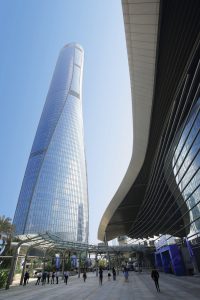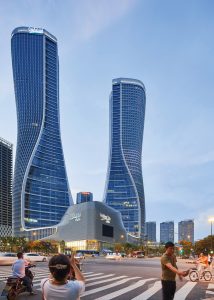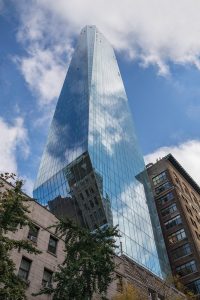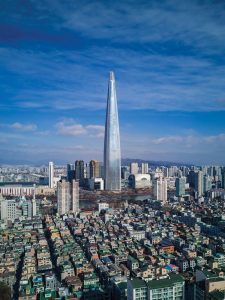2017 Sets Records for Geographical Diversity, Number, and Height of Skyscrapers
More buildings of 200 meters (656 feet) in height or taller were completed in 2017 than in any other year, with a total of 144 completions, marking the fourth consecutive record-breaking year. This was an increase of 95 percent from 2013 when only 74 buildings of 200 meters or more were completed. The total number of 200-meter buildings in the world is 1,319, an increase of 12.3 percent from 2016 and a 402 percent increase from 2000 when only 263 existed.
Notably, 2017 was also the most geographically diverse year regarding the number of cities and countries that completed 200-meter-plus buildings, with 69 cities across 23 countries represented in the data, up from 54 cities across 18 countries in 2016. High-rise construction is no longer confined to a select few financial and business centers, but instead is becoming the accepted global model for densification, as more than one million people on our planet urbanize each week. Thirteen cities saw their first 200-meter-plus high-rise completion in 2017, in addition to the 28 cities and eight countries that saw their tallest building completed this year.
Once again, for the tenth time in a row, China completed the greatest number of 200-meter-plus buildings in 2017, with 76 completions for 53 percent of the total. Although this is a slight decrease from 2016, when China completed 83 such buildings or 65 percent of the global total, China is still by far the world leader in skyscraper construction. In fact, the city with the most 200-meter-plus building completions, Shenzhen, China, finished 12 buildings or 8.3 percent of the year’s global completions – that is more than any other country, let alone city, except China itself. The United States completed the second-greatest number of 200-meter-plus buildings of any country, with 10 buildings finished in 2017.
Key Worldwide Market Snapshots of 2017
Asia (Not including the Middle East)
While 2017 may have been the most geographically diverse year for 200-meter-plus building completions, Asia retained its status as the world’s skyscraper epicenter, completing 109 buildings of at least 200 meters in height. The top two cities, Shenzhen and Nanning, are in China, with Jakarta (Indonesia) and Chengdu (China) tied for third place with five completions each.

10th tallest completed in 2017, Zhuhai St. Regis Hotel & Office Tower, Zhuhai, 322 meters. Courtesy of Jason Leung.
Surprisingly, Pyongyang, North Korea, tied for sixth place with four buildings of 200 meters or greater completed in 2017. Seoul, South Korea, completed three 200-meter-plus buildings, including Lotte World Tower, a 555-meter (1,821-foot) mixed-use building.

35th tallest completed in 2017, Raffles City Hangzhou Tower 1, Hangzhou, 254 meters.
Courtesy of Hufton+Crow.
Mumbai completed its new tallest building (as well as India’s), One Avighna Park, at 266 meters (873 feet). Two other 200-meter-plus buildings were completed in the coastal city in 2017. Sri Lanka also completed its new tallest building, the Grand Hyatt Colombo, which rises to 230 meters (755 feet).
The Middle East and Africa
The Middle East had nine completions of 200-meter-plus buildings in 2017. Dubai saw three completions in 2017, and all were supertall – the tallest of which, Marina 101, now holds the title of the 18th tallest building in the world at 425 meters (1,394 feet). Israel and Saudi Arabia tied with two 200-meter-plus completions, with Qatar marking one. Africa completed its second 200-meter-plus building, Britam Tower, which is both Kenya’s and its capital Nairobi’s first.
North America (includes Central America)
North America more than doubled its 2016 record with 15 tall building completions in 2017. This was reflected both in the United States, which saw 10 completions in 2017, and Canada, which completed five buildings of more than 200 meters in height. Toronto alone notably represented 80 percent of Canada’s tall building completions this year, as the city experiences an ongoing boom in high-rise construction. While not yet completed, Toronto’s first supertall – named The One – broke ground in late 2017.

62nd tallest completed in 2017, Madison Square Park Tower, New York City, 237 meters. Courtesy of Lester Ali.
In the United States, New York completed four 200-meter-plus buildings while two were completed in Chicago. Los Angeles completed one building of 200-plus-meters, the Wilshire Grand Center, which is now the city’s tallest at 335 meters (1,099 feet).
Mexico completed its tallest building, Torre KOI, a 279-meter (915-foot) mixed-use tower in San Pedro Garza Garcia. This marks the second year in a row that Mexico has crowned a new tallest building. Meanwhile, Panama City added two completions to its disproportionately large collection of high-rises, about 65 percent of which are residential.
South America
Only one tall building of 200 meters or greater was completed in 2017 in South America – the Hotel Estelar Bocagrande in Cartagena, Colombia, at 202 meters (663 feet).
Europe
Europe doubled its 2016 output with four buildings of at least 200 meters in height, all of which were in Turkey – three in Istanbul and one in Izmir. Skyland Towers, at 284 meters (932 feet), became Istanbul’s tallest and Europe’s seventh-tallest buildings.
Australia and Oceania
Two tall buildings of 200 meters or greater were completed in this region in 2017. Both were in Melbourne, Australia, and both were residential. Australia is amidst a building boom and is rapidly becoming one of the world’s most urbanized nations.
Completions by Function
The functional share of tall buildings in 2017 proved to be among the most interesting discoveries in the study, as the data showed a significant shift from all-office and mixed-used function to all-residential towers. Buildings with all-residential function spiked to 49 completions, or 34 percent of the total, up from just 19, or 15 percent of the total last year. At the same time, all-office building completions fell to 56, or 39 percent of the total, compared to 67, or 52 percent of completions in 2016. Of all the pure-office buildings completed, 44 (78.6 percent) were in China.
Completions by Material
Of the 144 buildings of 200 meters or greater height completed in 2017, 74, or 51 percent, used concrete as the primary structural material; 64, or 44 percent, used a composite of steel and concrete. The significant use of concrete can be attributed to a combination of concrete’s relative ubiquity and lower cost in many regions, as well as its comparative simplicity in construction, which would increase its appeal in regions with lower-skilled labor pools.
In 2017, two buildings had all-steel construction, consistent with the 2016 figure. As of this writing, there were only seventeen 200-meter-plus buildings currently under construction that employed all-steel structural systems.
“Supertall” Completions
A total of 15 supertalls (buildings of 300 meters (984 feet) or higher) were completed in 2017, tying with 2015, the first year to break this record. The total number of supertall buildings worldwide is now 126, up from 111 in 2016. This fact is even more extraordinary, considering that much of the activity has been in the past few years. The 2017 figure represents a 66 percent increase in just four years. In 2013, there were 76 buildings 300 meters or higher; in 2000, only 26.
The World’s 100 Tallest Buildings
Of the 100 World’s Tallest Buildings in 2017, 54 were in Asia, a figure unchanged from 2016. Twenty-six were in the Middle East, up from 24 the previous year. North America has 15 of the buildings on the list. Europe’s figure dropped from five in 2016 to four in 2017.
Mixed-use continues to dominate the functional mix of the tallest 100 buildings with 46 buildings, an increase from 41 in 2016. Meanwhile, office functions take a slightly lower share in 2017, with 38 buildings, down from 40 in 2016 and equal to the 2015 figure. Residential and hotel functions have shrunk as a proportion once again, with 11 and five buildings, respectively, down from 12 and seven in 2016.
Composite construction, in which a combination of steel and concrete components is used in the main structural elements, represents the majority of structural approaches to the 100 Tallest list, with 51 of the buildings being of composite construction, the same as in 2016. All-concrete buildings decreased by one to 34 from 35 in 2016. The number of all-steel buildings in the 100 Tallest list remains at 10 in 2017, as it was in 2016. Those buildings reported as being of “mixed” construction, in which distinctive sections of the buildings are predominantly steel or concrete, increased to five in 2017 from four in 2016.

Tallest completed during 2017: Ping An Finance Center, Shenzhen, 599 meters. Courtesy of Tim Griffith for KPF.
Two new additions were also added to the list of the World’s 10 Tallest Buildings in 2017 – the fourth and fifth tallest, Ping An Finance Center in Shenzhen and Lotte World Tower in Seoul, respectively. Ping An Finance Center rises 599 meters (1,965 feet), while Lotte World Tower reaches a pinnacle of 555 meters (1,821 feet). The completion of these two towers resulted in Petronas Twin Towers being removed from the World’s 10 Tallest Buildings list.

Second tallest completed in 2017, Lotte World Tower, Seoul, 554 meters. Courtesy of Tim Griffith for KPF.
Analysis
Overall, 2017 was a record-breaking year for skyscraper completions on a variety of fronts. We are once again witnessing an all-time-high for 200-meter-plus building completions, with this year’s total increasing by 350 percent over the past decade. While the total number of tall building completions is an important metric to watch, the data on the rapid geographic diversification of 200-meter-plus building completions in 69 cities across 23 countries is perhaps the most telling result. In 2007, only 20 cities across the globe completed 200-meter-plus buildings – the highest number on record at the time. A decade later, the number of cities represented in this report has more than tripled. A record 28 of those cities completed their tallest building in 2017.
China still leads the world in 200-meter-plus building completions, but the region may start to lose its dramatic lead as other regions, such as India, accelerate economic and population growth. North America, which for much of the 20th century completed the majority of 200-meter-plus buildings in the world, is also beginning to see a resurgence in tall building construction. In addition, new technologies and increased international capital flows are facilitating the creation of ever-taller skyscrapers.
The data from 2017 shows a continuation of the trend towards a higher global proliferation of skyscraper construction. Most of the prevailing trends of the past few years – the preponderance of construction taking place in Asia and, in particular, China, and the predominance of composite construction being used to achieve greater heights and more complex designs – have held steady.
However, a few discoveries this year are notable, if not wildly divergent.The increase in geographic diversity, such that 69 cities had at least one 200-meter building completion, up from 54 in 2016 – and 28 cities got a new tallest building – invites further scrutiny. Of these, 34 were in China. While not entirely surprising, nevertheless it is clear that, in addition to powerhouses like Shenzhen, there are also some smaller regional cities joining the list, such as Baoji in Shaanxi province; Yantai, in Shandong province; Lianyungang, in Jiangsu; and Yinchuan, in Ningxia. Although, in many cases, each of these cities has more than one million people and each has erected only a single building of 200 meters or more in 2017. The term “smaller regional city” is relative in China, which seems to be executing on its plan to create impressive skylines and more evenly distribute people in its campaign of mass urbanization.
Outside China, some infrequently-seen city names include Giv’atayim, Israel (near Tel Aviv); Izmir, Turkey; Nairobi, Kenya; and Pyongyang, North Korea. The reasons for this are likely as diverse as these countries are from each other; the functions span office, residential, and mixed-use.
The resurgence of all-residential tall buildings, against what had been an increasing trend towards a mix of functions, is also of interest. In the past, the Council on Tall Buildings and Urban Habitat (CTBUH) has credited the prevalence of the mixed-use function in buildings at the upper end of the height range to a developers’ hedging strategy. The greater the number of functions in the building, the less likely it is that economic weakness in one sector could delay or halt the project, or result in it being unsold or unrented for prolonged periods.▪
Research by Shawn Ursini & Marshall Gerometta, CTBUH
